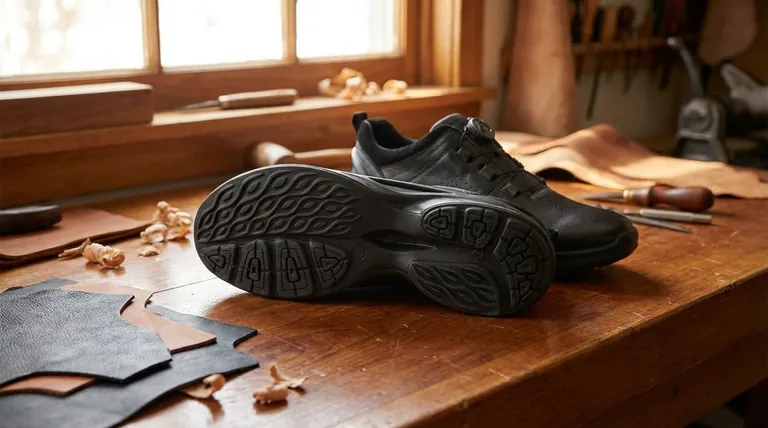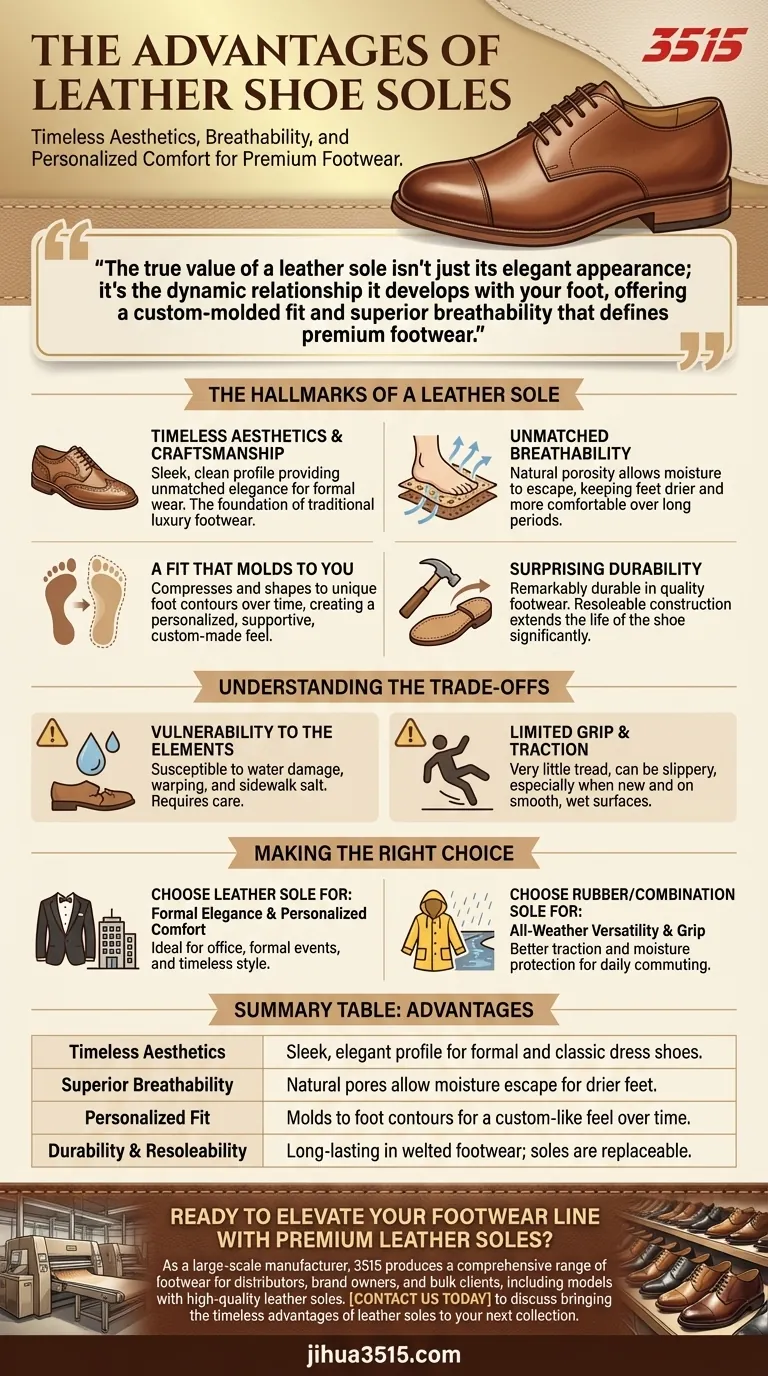When considering high-quality footwear, the advantages of leather soles center on their unique combination of timeless aesthetics, breathability, and the ability to mold to your foot over time. This creates a personalized fit and a level of comfort that synthetic materials struggle to replicate, making them a hallmark of classic dress shoes.
The true value of a leather sole isn't just its elegant appearance; it's the dynamic relationship it develops with your foot, offering a custom-molded fit and superior breathability that defines premium footwear.

The Hallmarks of a Leather Sole
Leather soles are not chosen by accident. They are a deliberate feature of high-quality shoemaking, prized for characteristics that enhance both the form and function of the shoe.
Timeless Aesthetics and Craftsmanship
A sleek leather sole is the foundation of a traditional dress shoe, like an oxford or loafer. Its clean profile provides an unmatched elegance that is often associated with superior craftsmanship and formal wear.
Unmatched Breathability
As a natural material, leather is porous. This allows it to breathe, helping moisture from your feet to escape. This key feature keeps your feet drier and more comfortable over long periods of wear compared to non-porous rubber or synthetic soles.
A Fit That Molds to You
Perhaps the most significant advantage is the way a leather sole breaks in. With wear, the leather slowly compresses and shapes to the unique contours of your foot, creating a personalized, supportive fit that feels custom-made.
Surprising Durability
While they require care, well-made leather soles are remarkably durable. In high-quality, welted footwear, they can last for several years and be replaced by a cobbler, significantly extending the life of the shoe.
Understanding the Trade-offs
To make an informed decision, you must also understand the inherent limitations of leather soles. Their classic benefits come with practical considerations.
Vulnerability to the Elements
Water is the primary adversary of a leather sole. Frequent exposure to wet conditions can cause the leather to degrade, warp, and wear out prematurely. Similarly, sidewalk salt in winter can cause significant damage.
Limited Grip and Traction
Leather soles offer very little tread. They can be quite slippery, especially when new and on smooth surfaces like tile or marble. This lack of grip is even more pronounced in wet conditions.
Making the Right Choice for Your Needs
Choosing the right sole depends entirely on how and where you plan to wear the shoes.
- If your primary focus is formal elegance and personalized comfort: A leather sole is the superior choice for office environments, formal events, and any situation where timeless style is paramount.
- If your primary focus is all-weather versatility and grip: You should consider rubber or combination soles, as they provide far better traction and protection from moisture for daily commuting or unpredictable weather.
Ultimately, choosing a leather sole is an investment in a classic aesthetic and a fit that becomes uniquely your own over time.
Summary Table:
| Advantage | Description |
|---|---|
| Timeless Aesthetics | Provides a sleek, elegant profile for formal and classic dress shoes. |
| Superior Breathability | Natural pores allow moisture to escape, keeping feet drier and more comfortable. |
| Personalized Fit | Molds to the unique contours of your foot over time for a custom-like feel. |
| Durability & Resoleability | In well-made, welted footwear, soles are durable and can be replaced to extend shoe life. |
Ready to elevate your footwear line with premium leather soles?
As a large-scale manufacturer, 3515 produces a comprehensive range of footwear for distributors, brand owners, and bulk clients. Our production capabilities encompass all types of shoes and boots, including models featuring high-quality leather soles that deliver the elegance and comfort your customers demand.
Contact us today to discuss how we can bring the timeless advantages of leather soles to your next collection.
Visual Guide

Related Products
- Wholesale Comfort Leather Business Shoes with Dial Lacing System
- Durable Leather Tactical Boots Wholesale & Custom Manufacturing for Brands
- Durable Leather Work Boots Wholesale Manufacturer & Custom Factory
- Durable Leather Work Boots for Wholesale & Custom OEM Manufacturing
- Safety Footwear Wholesale Manufacturer for Custom OEM/ODM Production
People Also Ask
- How does pull-up leather behave in shoes? It develops a unique, evolving patina.
- How can one identify authentic leather footwear? A Guide to Spotting Genuine vs. Fake
- What are the benefits of seamless leather in office work shoes? Eliminate Friction for All-Day Comfort
- What are the environmental benefits of choosing real leather shoes? Durability and Waste Reduction
- Are sneakers acceptable in a business casual workplace? How to Choose the Right Style



















